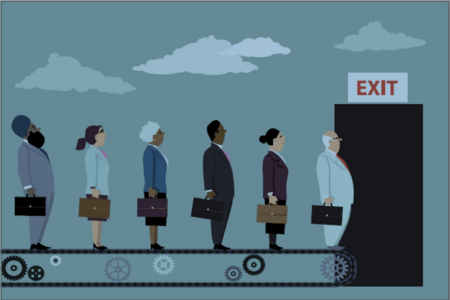
The impact of COVID is receding in the US, and workers for the first time in years are leaving their jobs in record numbers. In April of 2021 the number of workers who quit their job in a single month broke an all-time U.S. record, and in August according to a report from the Bureau of Labor Statistics released 11/21, another record-breaking 4.3 million Americans across a variety of industries quit their jobs. In addition, according to Gallup, 48% of America’s working population is actively job searching or watching for new opportunities. Economists are calling it the Great Resignation. While all industries either are now or soon will be affected by this trend, the three industries impacted the most by this are healthcare, hospitality and high tech.
-
Exactly half of U.S. workers describe their companies as being understaffed, and these workers are more likely to say they have recently considered quitting, according to a new (10/2021) CNBC workforce survey.
-
As companies struggle to hire new employees amid the labor shortage, employers also face greater risk of losing staff already dealing with high levels of pandemic-induced burnout and greater workloads.
-
To compound this situation, inflation in the US is at a 13 year high (5.4% in 11/2021 compared to 2% in 1/2020), and current trend analysis predicts a 25 year high in the coming months. This puts additional pressure on wage earners to capture the best income possible for their skills.
Causes
All economists can do is guess as to the cause, but big contributors include:
-
Remote Workforce. As COVID hit the U.S. much of the US workforce moved to working remotely. While COVID has now become much more manageable with vaccines and therapeutics, the move back to the office has not taken place on the scale in which it left. Companies have realized that they can expect equal or even greater productivity from a remote workforce. For those companies requiring workers to return onsite, this creates a competitive disadvantage to those companies that are continuing to allow remote work. This has also had a direct impact on workers portability; meaning that geography is no longer a primary concern for employment since a laptop doesn’t care where it is plugged in. Bottom line, the number of opportunities to change jobs is increasing exponentially.
-
Burnout. As more workers leave companies, the workload on those left behind increases and greater workloads and employee burnout occurs with more frequency. Nearly 30% of all US companies report that they consider their workforce understaffed and an accompanying 42% of workers feel they are being overworked because of it. This is something of a Catch-22, as burnout causes exiting and exiting causes burnout, but is very real and is often difficult to identify until it’s too late.
-
Vaccination Requirements. New federal vaccine mandates require that companies with 100 or more employees must require COVID vaccinations by 1/4/22. While current corporate vaccine compliance is very high, workers are reluctant to have their employers mandate how they manage their own health. This reluctance is a solid contributing factor to the resignation boom.
-
Within the healthcare industry, since June there have been more that 8,000 “reported” resignations due to vaccine mandates by hospitals; for employees the actual numbers may well be much higher. Hospitals are reporting a nearly 10% vacancy rate for RNs (up from 4% in 2020) and recruiting and on-boarding a new nurse takes an average of 89 days.
-
More than 60,000 U.S. Airforce personnel are facing disciplinary actions because they are refusing the vaccine mandate, and comparable numbers are being reported in the other military branches.
-
As of November 2021, roughly 58% of Americans have been fully vaccinated, but according to recent studies those who have not been vaccinated already are very unlikely to now get the vaccination.
-
Combating the Great Resignation
If there is any good news, it is that workers resigning during The Great Resignation are not leaving the workforce, they’re just moving around within it. There will continue to be a good source of future employees, but there will be a cost and burden associated with: 1) finding those new employees, 2) properly on-boarding and 3) training them until they are fully productive.
Companies should initiate aggressive moves to expand relationships with recruiting and search firms in their industries. RPO organizations can help develop solid scalable contingency plans for these types of hiring needs, but those plans need to be done in advance of the problem, not afterward. Every employer needs to know what the replacement cost is for each major role in their company.
Employee resignations will come at the worst possible time, so knowing the cost, having a plan and a partner in place to address needs quickly is essential.
Solutions
Short Term – Make your company as attractive as possible as quickly as you can
-
Immediately analyze current employee benefit plans and revamp them as necessary to be as attractive and as competitive as possible in this market. This analysis should also include an in-depth review of competitive employers’ offerings so that you can be sure that your benefits rank as high as possible. This effort will help both retain current employees and attract new hires as the need arises.
-
Gig workforce – short and intermediate term contract resources will need to be lined up (if not engaged) so that productivity will not suffer as resignations continue to increase. In 2017 as many as 34% of the overall workforce were Gig Workers. In 2020 that number was closer to 43%. There are Gig Workers for nearly any position that can fill in quickly. This is important to consider for all levels of employees; from the loading dock to the executive suite.
Long-Term – Everyone wants to know that they have a future with their employer, so tell them!
-
Employees want to know that their employer is willing to invest in their career development with a clear and definitive plan. Employees who feel appreciated are far less likely to look elsewhere for work.
-
Compensation plans will need to be reviewed for every level. Employers will need to compare the cost of a new hire vs. the cost of retaining current staff. Wage increases are more reasonable once you know what the replacement costs are. Recent reports estimate that annual employee raises for 2022 will increase at the fastest rate in over 20 years because of the very tight labor market.
-
Employee feedback to understand their pain points and then taking specific action is very important. Many employees feel like they aren’t being heard, especially when working remotely. This is at the same time they are also experiencing increased workloads, projects, and tasks that they have to address quickly. Getting employee feedback helps in several ways, but primarily it allows employers to get out in front of issues before they fester, and it tells the employee that management is interested in them and their circumstances. If specific and actionable issues are discovered, the cost of making changes can be compared with the risk and cost of resignations to determine the best path for the company.
-
Recognize that your employees are probably your greatest asset, and that this current resignation trend puts those assets at risk. Be intentional, make a plan, and take action before the issue becomes critical.
The Great Resignation trend will not last forever, but it can significantly impact business operations across all industries for the immediate future. Every organization needs to take a healthy look at their own operations, areas of exposure, and potential risks associated with this trend. Once you know where you stand, you can develop plans to mitigate the impact and have solid contingencies for weathering this storm.
Lane Tucker is the Director of FĒNEX Healthcare Consulting and has over 30 years of professional information system management and consulting experience.



